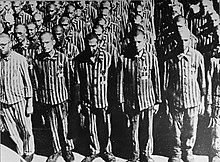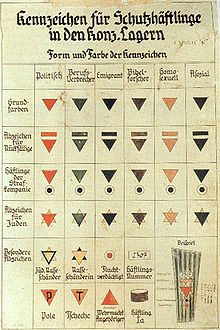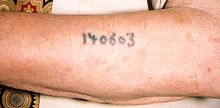Identification of the prisoners in the concentration camps

The identification of prisoners in the concentration camps was introduced in 1936 and was used to group and identify the prisoners in the concentration camps under the control of National Socialist Germany . It was used by the guards to identify the grouping of concentration camp inmates used by the SS by country, “race” , previous convictions, etc. (cf. National Socialist Racial Hygiene ). The prisoner number replaced the names of the prisoners in the camp.
Brief description
The marking was done with the help of colored fabric triangles, the tips of which pointed downwards or highlighted upwards. The badges, also called "angles", were sewn onto the striped concentration camp inmate clothing ( jackets and shirts ) so that the guards could identify the reason for their imprisonment.
Further differentiations were made according to nationalities and the tasks as prisoner functionaries (for example Kapos , room elder or block or barrack elder). In the first years of the concentration camp and in some cases later, the prisoner numbers were also put on clothing.
The embossing was chosen according to the danger signs in Germany. In addition to color coding, groups of inmates were put in letters in the triangle to indicate their country of origin. For example, a red triangle with an “F” indicated a political prisoner from France .
The most common "angles" were:
- black (previously brown) - " anti-social " or "unfit for community",
- later Sinti / Roma were marked with brown triangles (see Porajmos )
- green - criminals in preventive detention by the criminal police (“ professional criminals ”), called “BV-ler” in camp jargon
- purple - Bible Students :
- mainly Jehovah's Witnesses ( called Bible Students by the Nazi authorities , see Jehovah's Witnesses under National Socialism )
- Members of the Seventh-day Adventist Reformation Movement
- Free Bible Students
- pink - homosexual men (see homosexuals during the National Socialist era )
- red - political prisoners (only introduced at the end of 1937)
- blue - emigrants who returned to the German sphere of influence after emigrating
Double triangles:
- two yellow angles that were placed on top of each other and thus formed the Jewish star (see Holocaust )
- a red triangle on a yellow one - a Jew who was incarcerated as a political prisoner
The various markings were worn by one inmate at the same time, sometimes even more than six: so the first letters of the country of origin:
- "B" for Belgians
- "E" for " English ", ie British
- "F" for French
- "I" for Italians
- "J" for Yugoslavs
- "N" for Dutch
- "P" for Poland
- "S" for Spaniards
- "T" for Czechs
- "U" for Hungary
| Politically | Criminal |
emigrant |
Bible Students | Gay | Antisocial | |
| Simple angles |

|

|

|

|

|

|
| Repeated inmates |

|

|

|

|

|

|
| Members of a penal company |

|

|

|

|

|

|
| Markings for Jews |

|

|

|

|

|

|
| Special markings |
 “Jew. Racial abuse " |
 "Racial abuse" |
 Escape risk |
Inmate number |
 The applicable markings were carried in the following order: inmate number, stripe for repeated inmates, angle or star, member of a criminal company, suspect of escape |
|
 Pole: “P” on a red corner |
 Czech: "T" on a red triangle |
 Wehrmacht member : Upside down red triangle |
Special inmate: brown bracelet |
|||
Inmate numbers
Every prisoner received a registration number (prisoner number) when they were admitted to a main camp. From now on he no longer had a name in the camp, but was called with this number and had to report to each of his superiors with this number (with the cap off and in a careful attitude).

Usually the prisoner numbers were attached to the clothing. Only in the Auschwitz concentration camp were prisoners also tattooed . On the one hand to avoid confusion of undressed corpses and on the other hand to identify escaped prisoners more easily. Usually the inmate number was tattooed on the left forearm. Exceptions were children who were born in the camp. Since there was not enough space on their forearms for a tattoo, they were tattooed on other places (e.g. thighs) instead.
In Auschwitz there were also other classifications. For example the "Z-Series". These numbers were used for the gypsy camp from February 26, 1943 . Russian prisoners of war got the "R-series" from October 7, 1941. There was also the "A-series" for men from May to August 1944 and then the "B-series" until November. In addition, the “A and B series” were introduced from May 1944 for so-called “transport Jews”.
accounting
The numbers of the inmates recorded in this way were recorded in an accounting system in each camp and read out during the two daily roll calls on the roll call square . Before and after moving out to work details, changes (death, transfer to the precinct, dismissals) were checked using these numbers. They were also used to bill the prisoners' work to the companies, small businesses or authorities involved.
Using the numbers in the various camp accounts, it was sometimes possible to track individual transports of prisoners between the concentration camps in the post-war period even if the prisoners were later killed or were considered missing. Especially when transporting prisoners from the occupied countries of Europe, this was often the only way to determine the place of death and the probable time of death.
Some of the series of numbers of individual concentration camps contained additions for individual groups of victims. When moving to a different main camp, new numbers were sometimes assigned.
literature
- Eugen Kogon : The SS State - The System of the German Concentration Camps. (= Heyne books 19 = Heyne non-fiction book 9). Approved, unabridged paperback edition, 43rd edition. Heyne, Munich 2006, ISBN 3-453-02978-X .
- Christa Schikorra: Continuities of Exclusion. “Asocial” prisoners in the Ravensbrück women's concentration camp (= Center for Research on Antisemitism at the Technical University of Berlin. Series of documents, texts, materials. Vol. 41). Metropol, Berlin 2001, ISBN 3-932482-60-3 .
Web links
- Triangles, and Markings. Retrieved February 8, 2012.
- The men with the pink triangle - homosexuals in Nazi concentration camps. rosa-winkel.de; Retrieved February 8, 2012.
- Wolf Oschlies: The system of the National Socialist concentration camp . Shoa.de; Retrieved February 8, 2012.
Individual evidence
- ↑ on the subject of lesbian women who were allegedly marked with a black triangle, see Homosexuals during the National Socialist era
- ↑ Gelsenkirchen center - Portal for Urban and Contemporary History

